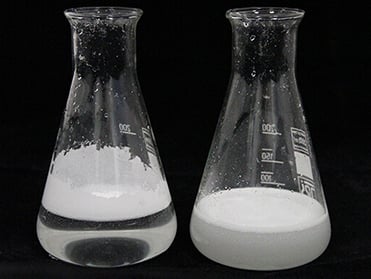
Thierry Plasma's hydrophilic plasma treatment of UHMW polyethylene powder is used to improve dispersion in difficult materials and solutions.
For many applications, hydrophilic UHMW polyethylene powder is used as an innovative option. It can be used as an additive in rubber, resulting in an increased tear propagation strength. Furthermore, hydrophilic PE powder can increase the bonding strength between metal and plastic. This hydrophiling is made possible by low-pressure plasma treatment.
The treatment parameters strongly depend on the particle size of the powder. Plasma treatment can take between 5 minutes and several hours. The risk of thermal damage to the power can be ruled out since the process is constantly carried out at low temperatures for this type of treatment.
Likewise, basic properties of the powder such as melting temperature, degree of crystallization and molar weight are not affected. Via a wide range of variable process parameters, many different coat properties can be achieved.
UHMWPE (ultra-high molecular weight polyethylene) is a polyethylene with a very high molecular weight. Polyethylene can be regarded as the plastic with the simplest structure: a chain of carbon atoms, only hydrogen at the sides. When this chain is very long, the material is described as UHMWPE.
To learn more about the use of plasma in manufacturing, please read our eBook titled "Manufacturer’s Surface Activation Guide for Improved Adhesion."
UHMW stands for ultra-high molecular weight, while polyethylene (PE) is a class of polymers. There are many variations of PE but the thing they have in common is their chemical structure. Those molecules consist of long chains with links made of (C2H4)n. Here, the ‘n’ denotes the number of chain links in a PE molecule. UHMW PE has several interesting properties, such as low friction (in fact, it is self-lubricating), high impact strength and high abrasion resistance.
UHMW PE can be conveniently ground into a powder, which basically keeps the advantageous properties of the bulk material. Typical grain sizes range from some dozens to several hundred microns. Depending on the size of the particles, there are several possible uses of the powder. It is, for example, used as an additive in rubber components and makes the rubber more wear-resistant and reduces the friction coefficient. The very fine-grained powder can be added to grease or lubricants to enhance the gliding properties even more. One can also add UHMW PE powder to paints and other coatings as it has excellent dispersion behavior. Surfaces that are covered with such paint or coating will exhibit very low friction and good wear resistance at the same time.
Plasma-activated powders have many possible applications. For example, a quite recent paper has demonstrated that the oxygen plasma treatment of PE powder has led to an increase in wettability of about 220 %. Furthermore, another group showed that treating PE with plasma leads to a decrease in the molecular weight without influencing other properties of the powder. Adhesion of PE powder to metal and glass substrates could be improved fivefold with plasma treatment. This can yield exciting new methods for composite material manufacturing. Other polymers such as polystyrene exhibit improved hydrophobicity after CF4 plasma-treatment.
However, also powders of other materials can be plasma treated for obtaining different effects. It has been shown that metallic or ceramic grains could be densified by plasma treatment. Last but not least, even unusual powders such as onion or milk powder have been plasma treated in order to enhance microbial safety.
Hence, useful applications of plasma activation of powders can be summarized as:
If UHMW PE power is added to paints, the grain size should be in the range of 30 and 60 µm. Paint, which contains these grains exhibits some interesting features. It will have a favorable surface texture with little gloss and high wear resistance. It will also have a decreased coefficient of friction that enables objects to slide across the surface easily. Thus, paints with UHMW PE additives act as lubricant varnishes on a large variety of surfaces.
Plasma has superior disinfection ability on powder surfaces. Hence, it can be applied to enhance food safety and hygiene in edible powders. These powders can be spices, seeds, milk powder, etc. The plasma treatment is usually carried out under atmospheric pressure. This is especially important when it comes to the treatment of spices because it preserves the fugacious aromatic molecules of the spices. The plasma itself can be created in various gases like CO2, argon, nitrogen, air, or gas mixtures.
Using plasma-treated PTFE powder as an additive for lubricants can significantly enhance the wear and friction properties and improve the sliding behavior between two surfaces. This was, for example demonstrated for air plasma treated PTFE/Nomex composite materials. Another utilization of argon plasma on PTFE fibers also yielded good results with respect to wear resistance and friction reduction.
There is a lot of ongoing research into using UHMW plastics for increasing wear resistance. A very recent paper from 2020 by Muhandes et al. compared the abrasion and wear of different polymers. The authors showed that UHMW-PE performed best with regard to wear resistance along with polyamide. Furthermore, it exhibits the lowest friction force among all materials that were tested in this publication. This means it has also superior tribological properties compared to other plastics.
No matter what kind of powder you want to treat with plasma, Thierry Corp. has the right plasma systems for all your purposes!